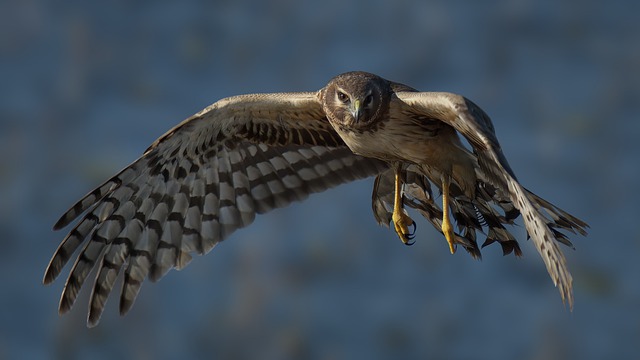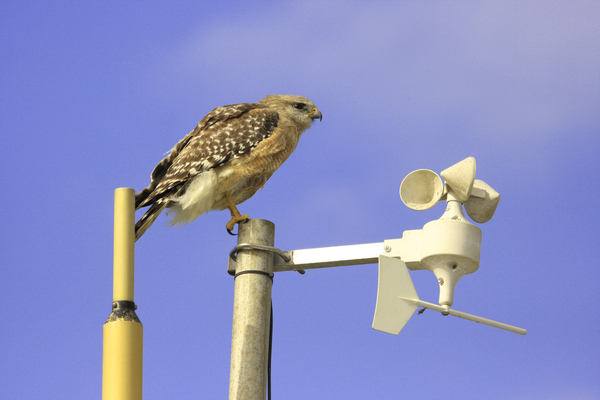Hey there, if you’re an avid bird watcher or just enjoy seeing birds of prey in the wild, then you’re going to love this article!
In this piece, I’ll be sharing with you seven types of hawks that you can spot in South Carolina (SC).
From the regal Red-tailed Hawk to the fierce Cooper’s Hawk, these birds are a sight to behold.
So, without further ado, let’s take a closer look at the fascinating world of hawks in South Carolina!
| Image | Name |
|---|---|
 | Broad-winged Hawk |
 | Cooper's Hawk |
 | Northern Harrier |
 | Red-Tailed Hawk |
 | Sharp-Shinned Hawk |
 | Red-shouldered Hawk |
 | Osprey |
Types of Hawks in South Carolina (SC)
1. Broad-winged Hawk

The only time you’ll see a Broad-winged Hawk throughout South Carolina is in the summer and spring when they go north to nest.
Smaller than other hawks, this species is distinguished by its brown head and breast, white underside, and white and black tail bars.
When in flight, you notice the short tail and large wings having pointy ends.
During the mating season, these hawks prefer to be alone.
They like to raise their young in remote areas, such as waterways or woods.
Insects, amphibians, and small animals like toads and frogs make up the bulk of their food.
The greatest time to observe a broad-winged hawk is in the autumn when they are migrating back to South America from northern breeding grounds.
The sky is filled with “kettles,” or flocks, that may include tens of thousands of birds.
You can see them in the woods even if you’re not on their migratory path.
You may easily spot them by the sharp whistles they make.
2. Cooper’s Hawk

Cooper’s Hawks are widespread throughout North America, including permanent populations across South Carolina.
The back of an adult is a bluish-gray color, while the breast is heavily barred with orange, the eye is red, and the forehead is rounded off with a black cap.
Young birds have bright yellow eyes, a brown upper body, and a white belly heavily streaked with brown color.
The woods and forests are their natural environment, although they also appear to do well in suburban areas.
They mostly subsist on tiny birds, which they capture with adept aerial hunting.
Cooper’s hawks are common garden visitors, and some have even reported seeing them attack birds at a feeder, particularly pigeons, starlings, and doves.
Studies of Cooper’s hawk bones show that most of them had at one time shattered bones in their chest from flying through trees and vegetation at great speed in pursuit of birds.
3. Northern Harrier

The northern harrier looks like an owl in that it is sophisticated and graceful.
This disc-shaped face helps them hunt both visually and aurally, just as an owl’s face does.
Their long tail and a white spot above the tail may be used as landmarks in identification.
They are easily recognizable in the air due to their distinctive “V”-shaped wing position.
You could not have chosen a better term to refer to these birds.
This hawk is mostly a winter visitor to South Carolina.
You can see them all around the state, but they congregate most often near the water.
Over open terrains, such as plains, marshes, and farms, you could see one.
Nesting on the ground amongst thick vegetation, including willows, reeds, cattails, and sedges, this hawk is unusual in that it does not choose a tree for its nest.
Males may possess two or more partners at once, and all of them contribute to the care of the female and her young by providing food.
4. Red-Tailed Hawk

The red-tailed hawk is among the most common hawk across North America, and it can be seen in nearly all states, notably South Carolina, where it lives all year round.
During the wintertime, their numbers swell even further as birds that spent the summer across Canada migrate south to join their fellow Americans.
Throughout the day or in the early morning, you may sometimes see a red-tailed hawk flying above in search of food with its keen eyesight or sitting on a telephone pole by the side of the road.
Mice, rats, rabbits, and squirrels are among their favorite prey.
Possible prey items include birds and snakes.
The tail of an adult is a distinctive brick red, whereas youngsters possess stripes of white and brown.
These hawks often have a white underside and a dark brown upper body.
They are easily recognized by the brown streaks on their breasts and the strip of deeper brown streaks that runs over their bellies.
The extensive distribution of these hawks has resulted in a wide range of coloration.
The lengthy cry of the red-tailed hawk has come to symbolize all raptors.
Whenever an eagle or hawk appears on screen, the sound of this bird’s shriek is employed.
5. Sharp-Shinned Hawk

The sharp-shinned hawk is the shortest of the American hawk species.
They are permanent inhabitants in the western portion of the state, while in the eastern section, they might only be there during the wintertime.
These hawks hunt birds and small mammals by chasing them through the woods.
They are difficult to see during the breeding season because they prefer canopies of deep woodlands.
On occasion, they may come into backyards in search of the birds that frequent the feeders.
However, the autumn migration is the greatest time to see them.
Large numbers of them may be observed at hawk watch locations in the United States as they migrate south from their summertime territory in Canada.
The back of a sharp-shinned hawk has a blue-gray tint, while the bird’s breast and tail are each barred with reddish orange.
Their appearance is quite identical to that of the cooper’s hawk, to which it is sometimes compared.
6. Red-shouldered Hawk

Within their native range, which includes most of the eastern United States and the western parts of California, red-shouldered hawks are rather numerous.
They spend the whole year visiting South Carolina.
The breasts are quite red, and the coloration continues all the straight down the abdomen, making an easy identification.
Its wings and back are covered with dark, almost black feathers.
This will be complemented by a scattering of reddish feathers around their “shoulders” and upper back (hence their name).
The black feathers on its body will be heavily banded at the base, while the white barring will begin at the bird’s midback and continue all the way down to its tail.
This hawk’s call might give it away before you ever see it.
The “keee-aaah” call they make is frequently repeated numerous times.
Some have compared the noise to that of a bird.
They make loud calls to declare their territory or to sound the alarm.
These hawks are primarily forest dwellers and hunters, and they like moist forest environments.
In suburban regions with a mixture of trees and buildings, you may also find them.
This species of hawk is sometimes confused with the more common red-tailed hawk, but it is easy to tell the two apart if you know what to look for.
7. Osprey

Ospreys are visually similar to hawks and are linked to them, but their DNA is distinct enough to warrant their own taxonomic category.
Ospreys are a kind of raptor that can only be seen near water since its food is nearly entirely made up of fish.
Their grip may be adjusted on the go by moving the toes’ outermost digit.
This change helps them hold onto the slippery fish they grab.
In much of South Carolina, you may see ospreys at any time of the year.
You may locate them in close proximity to shallow fish-filled lakes, rivers, reservoirs, and marshes.
They are common in the state’s coastal areas and on big bodies of water, including Lake Moultrie, Lake Marion, Lake Wateree, and Lake Murray.
When compared to hawks, their color is quite obvious.
They possess an extremely pointed beak and a white head, having a big dark brown stripe over each eye.
Its upper parts, including its back and wings, are just a dark brown color, while its underside is a pristine white.
Their speckled undersides give off the impression of a dark brown “wrist” while they’re in flight.
Ospreys prefer to nest on cliff faces or in high trees, although they will sometimes utilize manmade platforms.
Platforms for ospreys have been installed in several states near water sources in an effort to protect them.
Conclusion
In conclusion, South Carolina is home to a diverse range of hawks, each with their own unique characteristics and behaviors.
From the regal Red-tailed Hawk to the fierce Cooper’s Hawk, these birds of prey are an integral part of the ecosystem and play a crucial role in maintaining the balance of nature.
As we continue to appreciate the beauty and importance of these magnificent creatures, it is important to also work toward their conservation and protection.
By supporting efforts to preserve their habitats and raising awareness about their importance, we can ensure that these amazing birds will continue to soar over the skies of South Carolina for generations to come.
FAQ
Where can I spot hawks in South Carolina?
Hawks can be spotted throughout South Carolina, but are most commonly found in open habitats such as grasslands, savannas, and wetlands.
When is the best time of year to spot hawks in South Carolina?
The best time of year to spot hawks in South Carolina is during their fall migration, which typically occurs from late August to early December.
What is the wingspan of a hawk?
The wingspan of a hawk can vary depending on the species but ranges from around 20 inches for the Sharp-shinned Hawk to up to 8 feet for the Bald Eagle.
Are hawks protected in South Carolina?
Yes, hawks are protected under state and federal laws in South Carolina, including the Bald and Golden Eagle Protection Act and the Migratory Bird Treaty Act.
How can I help protect hawks in South Carolina?
You can help protect hawks in South Carolina by supporting conservation efforts, such as habitat preservation and restoration, reducing pesticide use, and reporting incidents of illegal hunting or harassment of birds of prey.
Last Updated on April 14, 2023 by Lily Aldrin
